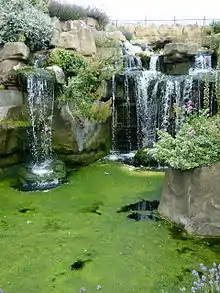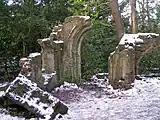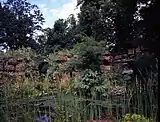Pulhamite
Pulhamite was a patented anthropic rock material invented by James Pulham (1820–1898) of the firm James Pulham and Son of Broxbourne in Hertfordshire.

Waterfall in Albion Place Gardens, Ramsgate
Overview
Pulhamite, which usually looked like gritty sandstone, was used to join natural rocks together or crafted to simulate natural stone features. It was so realistic that it fooled some geologists of the era.[1] The recipe went to the grave with him.[2] Modern analysis of surviving original Pulhamite have shown it to be a blend of sand, Portland cement and clinker sculpted over a core of rubble and crushed bricks.[3]
- Neo-Norman gatehouse and folly at Benington Lordship in Hertfordshire
- Cascade and Rock Garden, Ramsgate[4]
- Garden Folly, Sydenham Hill Wood, Sydenham, London.
- Grottoes at Dewstow Gardens, South Wales
- Dunorlan Park, Tunbridge Wells[5]
- Felixstowe Spa and Winter Garden, Suffolk [6]
- Fernery and waterfall, Bromley Palace Park, Bromley[7][8]
- Grotto, Wotton House, Surrey
- Henley Hall, Shropshire
- Lake and rockery, Milton Mount Gardens, Crawley[9][10]
- Newstead Abbey fernery, Nottinghamshire[11]
- Rock Cliff, Bawdsey Manor, Suffolk[12]
- Water Garden, Highnam Court, Gloucester[13]
- Zig-zag Path, Lower Leas Coastal Park, Folkestone[14]
- Rosshall Park, Glasgow
- Gardens at Waddesdon Manor, Buckinghamshire[15]
- Heythrop Park, Oxfordshire
- Fernery at Danesbury Park, Hertfordshire.
- Waterfall at Battersea Park, London.
- Gardens at Coombe Wood, Croydon.
Gallery
 Pulhamite cliff walk at Bawdsey Manor
Pulhamite cliff walk at Bawdsey Manor Folly in Sydenham Hill Wood
Folly in Sydenham Hill Wood Pulham rocks in the Water Garden at Waddesdon Manor estate
Pulham rocks in the Water Garden at Waddesdon Manor estate Zig-zag Path in Folkestone
Zig-zag Path in Folkestone Pulhamite grotto at Wotton House, Surrey
Pulhamite grotto at Wotton House, Surrey
See also
References
- Marion Harney (2014). Gardens and Landscapes in Historic Building Conservation. John Wiley & Sons. p. 460. ISBN 1118508130.
- The Pulham Legacy
- James Stevens Curl and Susan Wilson (2015). The Oxford Dictionary of Architecture. Oxford University Press. p. 606. ISBN 0199674981.
- "Rock Gardens and Cascade, Ramsgate". www.britishlistedbuildings.co.uk. Retrieved 21 February 2014.
- "History of Dunorlan Park". tunbridgewellsmuseum.info. 2013. Archived from the original on 7 January 2014. Retrieved 6 January 2014.
- Historic England. "Cliff Gardens and Town Hall Garden (1001220)". National Heritage List for England. Retrieved 22 September 2014.
- "Pulhamite Fernery, Bromley Palace Park, Bromley". britishlistedbuildings.co.uk. Retrieved 21 February 2014.
- "Pulhamite Waterfall in Bromley Palace Park, Bromley". www.britishlistedbuildings.co.uk. Retrieved 21 February 2014.
- "Pulhamite Rock Islet in Lake at Milton Mount Gardens (Former Worth Park), Crawley". britishlistedbuildings.co.uk. Retrieved 21 February 2014.
- "Pulhamite Rockery at Milton Mount Gardens (Former Worth Park Gardens), Crawley". britishlistedbuildings.co.uk. Retrieved 21 February 2014.
- "About Newstead Abbey". www.nottinghamcity.gov.uk. 2012. Archived from the original on 4 January 2014. Retrieved 3 January 2014.
- "Bawdsey Manor Pulhamite Cliff Structures, Bawdsey". britishlistedbuildings.co.uk. Retrieved 21 February 2014.
- "Pulhamite Water Garden". britishlistedbuildings.co.uk. Retrieved 5 May 2014.
- "Pulhamite Caves, Folkestone". britishlistedbuildings.co.uk. Retrieved 21 February 2014.
- "Explore the gardens - Waddesdon Manor". Waddesdon Manor. Retrieved 2017-05-04.
External links
- The Pulham Legacy
- Durability Guaranteed – Pulhamite Rockwork pdf file on the English Heritage website.
- The Story of Pulhamite Rockwork
- Pulham at Waddesdon Manor video
This article is issued from Wikipedia. The text is licensed under Creative Commons - Attribution - Sharealike. Additional terms may apply for the media files.
